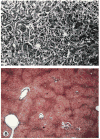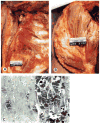Liver failure occurring as a component of exertional heatstroke
- PMID: 2013389
- PMCID: PMC2976649
Liver failure occurring as a component of exertional heatstroke
Abstract
An unusual case of an exertional heatstroke in a healthy 25-year-old man is presented. Initially, the patient was deeply comatose and developed severe rhabdomyolysis and massive hepatic necrosis. Subsequently, he received a liver transplant with remarkable improvement in his mental status, although the rhabdomyolysis continued. The patient died 41 days after the transplant due to a complicating infection. Providing that infections can be effectively controlled, liver transplants might be a promising therapeutic alternative for the few patients who survive the initial neurological consequences of this unusual event.
Figures



Similar articles
-
Prolonged rhabdomyolysis in a young man with exertional heatstroke.South Med J. 1983 Dec;76(12):1593. South Med J. 1983. PMID: 6648631 No abstract available.
-
[Heatstroke: a rare cause of massive hepatic necrosis due to hypoxia].Gastroenterol Clin Biol. 1988 Aug-Sep;12(8-9):668-9. Gastroenterol Clin Biol. 1988. PMID: 3063579 Review. French.
-
Hepatic failure in fatal exertional heatstroke.Aust N Z J Med. 1994 Feb;24(1):69. doi: 10.1111/j.1445-5994.1994.tb04433.x. Aust N Z J Med. 1994. PMID: 8002866 No abstract available.
-
Successful conservative management of acute hepatic failure following exertional heatstroke.Eur J Gastroenterol Hepatol. 2003 Oct;15(10):1135-9. doi: 10.1097/00042737-200310000-00013. Eur J Gastroenterol Hepatol. 2003. PMID: 14501625
-
Renal failure and heatstroke.Ren Fail. 1995 Mar;17(2):171-9. doi: 10.3109/08860229509026254. Ren Fail. 1995. PMID: 7644768 Review.
Cited by
-
Acute liver damage and ecstasy ingestion.Gut. 1996 Mar;38(3):454-8. doi: 10.1136/gut.38.3.454. Gut. 1996. PMID: 8675102 Free PMC article.
-
The effect of heat stress on the induced hepatic drug metabolizing system in rats.Eur J Drug Metab Pharmacokinet. 2002 Apr-Jun;27(2):69-73. doi: 10.1007/BF03190418. Eur J Drug Metab Pharmacokinet. 2002. PMID: 12064373
-
A Case of Exertional Heat Stroke Complicated by Hypoxic Hepatitis.Case Rep Emerg Med. 2020 Mar 30;2020:8724285. doi: 10.1155/2020/8724285. eCollection 2020. Case Rep Emerg Med. 2020. PMID: 32292608 Free PMC article.
-
Fulminant liver failure following a marathon: Five case reports and review of literature.World J Clin Cases. 2019 Jun 26;7(12):1467-1474. doi: 10.12998/wjcc.v7.i12.1467. World J Clin Cases. 2019. PMID: 31363475 Free PMC article.
-
Machine learning-based mortality prediction model for heat-related illness.Sci Rep. 2021 May 4;11(1):9501. doi: 10.1038/s41598-021-88581-1. Sci Rep. 2021. PMID: 33947902 Free PMC article.
References
-
- Hassanein T, Razack A, Gavaler JS, Van Thiel DH. Heatstroke: its clinical and pathological presentation, with particular attention to the liver. Dig Dis Sci. (in press) - PubMed
-
- Shibolet S, Coli R, Gilat T, Sohar E. Heat stroke: its clinical and mechanism in 36 cases. QJ Med. 1967;36:525–548. - PubMed
-
- Malamud N, Haymaker W, Custer RP. Heat stroke, a clinicopathologic study of 125 fatal cases. Milit Surg. 1946;99:397–449. - PubMed
-
- Kew MC, Bersohn I, Seftel HC, Kent G. Liver damage in heatstroke. Am J Med. 1970;49:192–202. - PubMed
-
- Rubel LR, Ishak KG. The liver in fatal exertional heatstroke. Liver. 1983;3:249–260. - PubMed
Publication types
MeSH terms
Grants and funding
LinkOut - more resources
Full Text Sources

